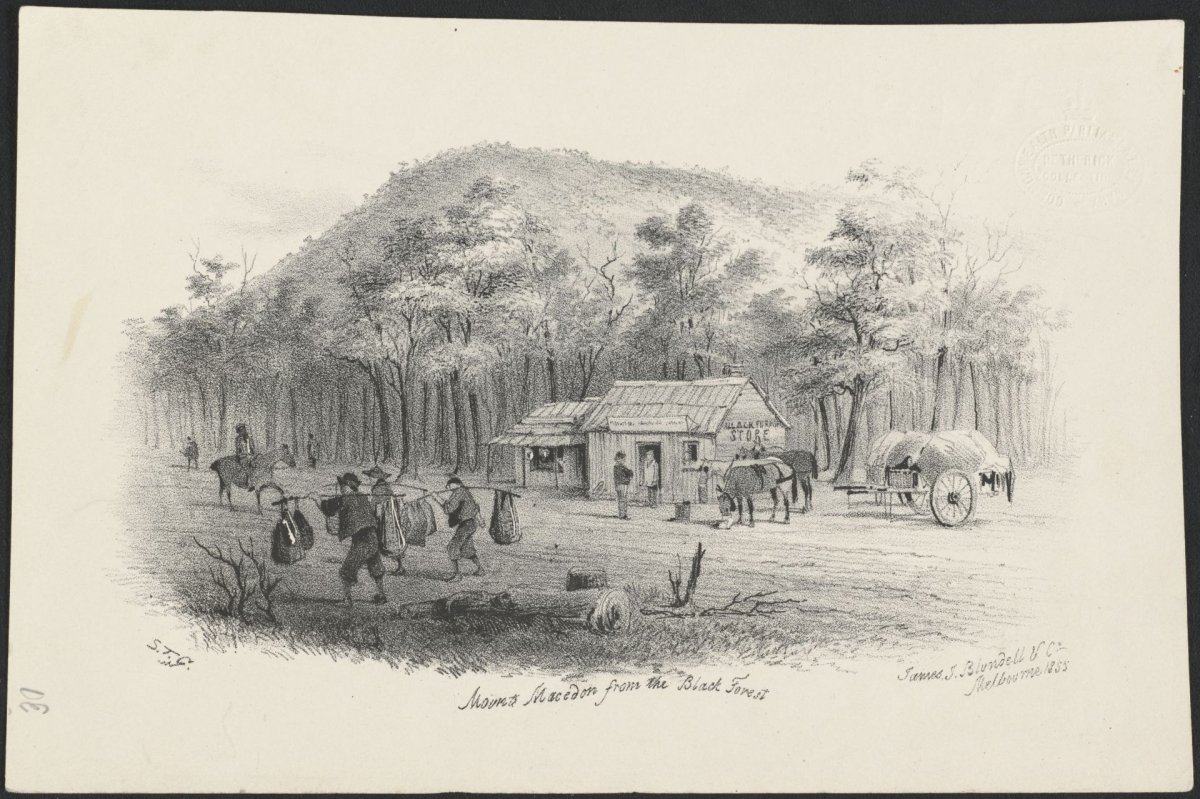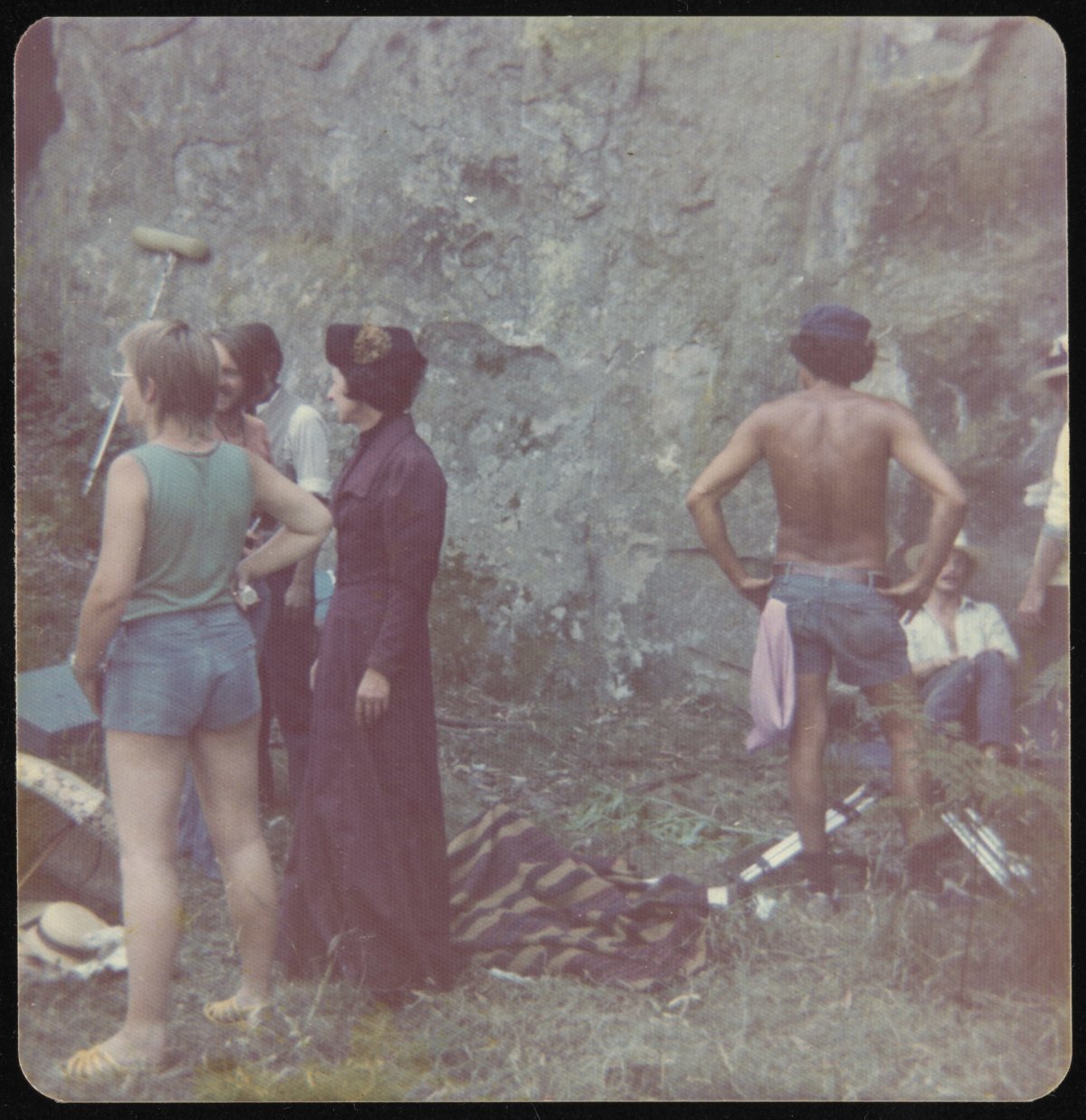Due to scheduled maintenance, the National Library’s online services will be unavailable between 8pm on Saturday 7 December and 11am on Sunday 8 December (AEDT). Find out more.
Picnic at Hanging Rock
This activity provides students with context and background information about the physical location and cultural environment in which Picnic at Hanging Rock is set.
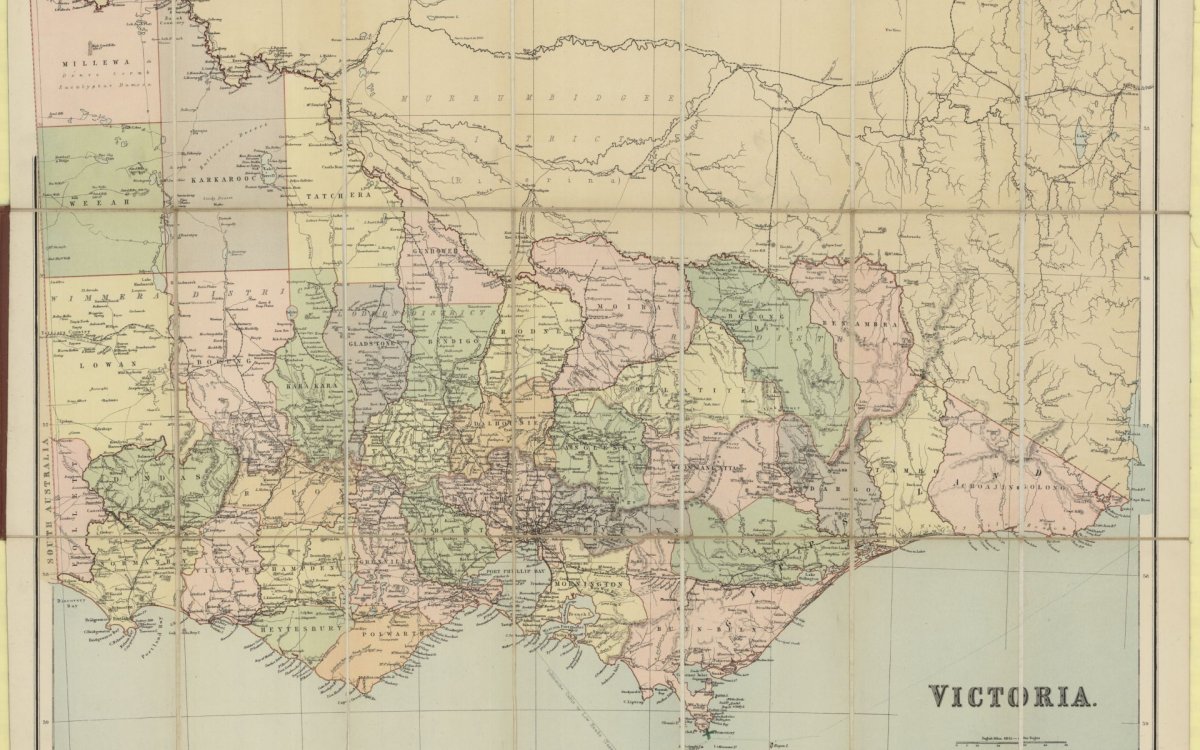
George Philip & Son. (1885). Victoria. http://nla.gov.au/nla.obj-232528783

Geological Survey of Victoria & Taylor, Norman, 1834-1894 & Wilkinson, J., draughtsman & Ross, J. L. (John Lidgate) & Selwyn, Alfred R. C., 1824-1902 & Shepherd, R., 1825-1885. (1860). Geological Survey of Victoria. No. 6 [cartographic material]. https://nla.gov.au/nla.obj-235069211
1. As a class, study the maps above and locate these key areas referred to in the novel:
- Woodend
- Macedon
- Castlemaine
- Hanging Rock (Mount Diogenes)
- Melbourne
Zoomable versions:
- George Philip & Son, cartographer, 1885, Victoria
- Geological Survey of Victoria & Taylor, Norman & Wilkinson, J & Ross, J. L & Selwyn, Alfred R. C & Shepherd, R. (1860)
How far are these places from each other? How far are they from Melbourne? What would this mean in terms of travel time in 1900?

Johnson, Sydney. (1910). Hanging Rock Races, New Year's Day, Woodend, Victoria / Sydney Johnson. http://nla.gov.au/nla.obj-153094653

Chevalier, Nicholas, 1828-1902 & Bruce, Robert, active 1866-1886. (1868). Picnic party at Mount Macedon [picture] / N.C. 1868 ; R. Bruce sc. http://nla.gov.au/nla.obj-136140491
2. Hanging Rock has been a popular outdoor recreation area for many years. Study the pictures above and discuss the following:
- What’s happening in the images?
- How are people dressed? Does their clothing look appropriate for summer in Australia? Why would they be dressed this way?
What other activities might people from the early 1900s be doing at Hanging Rock?

Caire, Nicholas, 1837-1918 & Anglo-Australasian Photographic Company. View of the Hanging Rock near Mount Macaedon [Victoria] [picture] / N. J. Caire. http://nla.gov.au/nla.obj-146727970
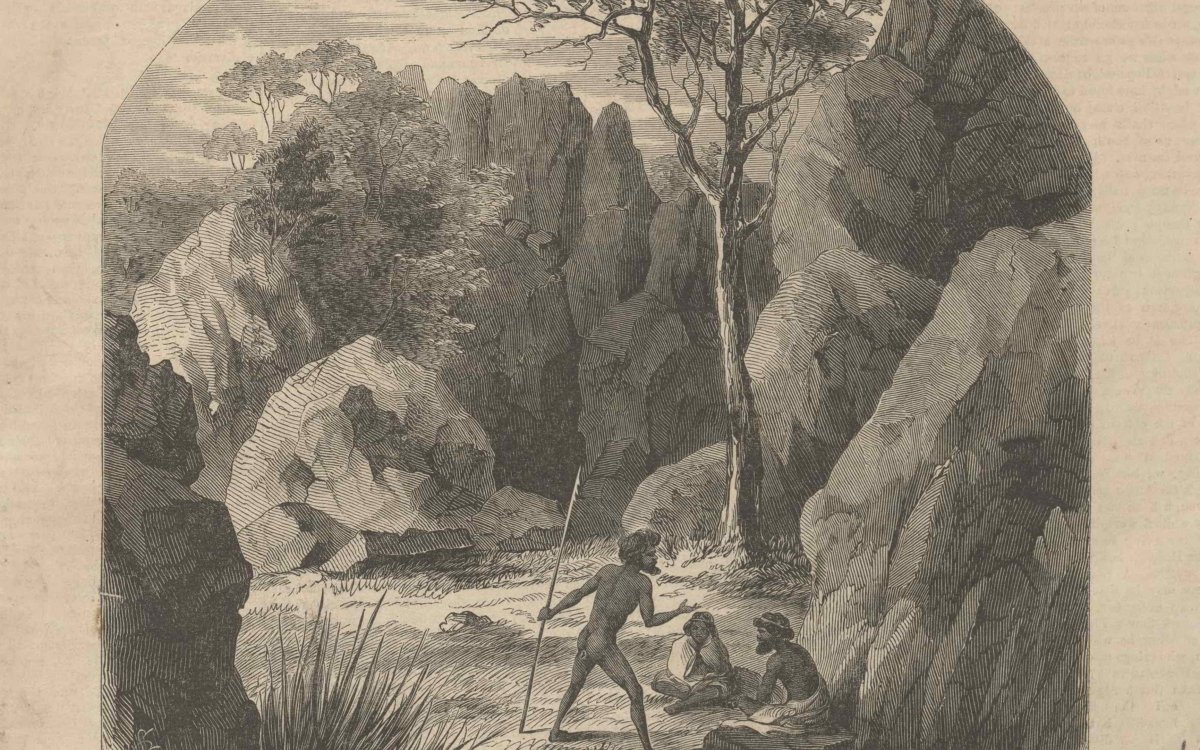
Calvert, Samuel, 1828-1913. (1863). Scenery at Mount Macedon, 1863 [picture] / S.C. http://nla.gov.au/nla.obj-140429536
3. Hanging Rock is an important site to the Wurundjeri people, part of the collective of displaced Aboriginal groups, the Kulin Nation (also known as the Kulin alliance). Using the following questions, have students research the traditional custodians of the Macedon Ranges and surrounding areas:
- Where are the traditional custodians now?
- Why was Hanging Rock an important place to them?
- What did they do at Hanging Rock?
- What else can you find out about the traditional custodians?
Fact or fiction?
Lindsay has peppered her novel with hints to indicate both that the story could be real and that it could be fake.
The novel opens with a note from the author:
Whether Picnic at Hanging Rock is fact or fiction, my readers must decide for themselves. As the fateful picnic took place in the year nineteen hundred, and all the characters who appear in this book are long since dead, it hardly seems important.

Lindsay, Joan, 1896-1984 & Fabinyi, Andrew, 1908-1978. (1967). Typescripts, [ca. 1967] [manuscript]. http://nla.gov.au/nla.obj-573778720
Many people have taken this to mean that the events of Picnic at Hanging Rock were true or at least based on real events.
- Does it matter to you whether the story is true or not?
- Why do you think the author doesn’t tell readers whether the story is true or not?
- Compare your feelings about the story—if you assumed the story were true and if you assumed the story were pure fiction.
- What clues are there in the novel that tell you whether the story is real or not? Consider locations, dates, references to newspaper articles.

Gill, Samuel Thomas, 1818-1880. Diggers and diggings of Victoria as they are in 1855 & James J. Blundell & Co. (Melbourne, Vic.) & Gill, Samuel Thomas, 1818-1880. (1855). Mount Macedon from the Black Forest [picture] / S.T.G. http://nla.gov.au/nla.obj-135634579

Prout, John Skinner, 1805-1876. (1847). [Mount Macedon, Victoria] [picture] / [John Skinner Prout]. http://nla.gov.au/nla.obj-134411173

Graham, H. J. (Harold John), 1858-1929. (1880). Mt. Macedon [picture] / [H.J. Graham]. http://nla.gov.au/nla.obj-135531041
For Cynics, the purpose of life was to live simply and to reject wealth, fame and power. The first philosopher to outline these themes was Antisthenes, who had been a pupil of Socrates in the late fifth century BC. He was followed by Diogenes of Sinope—a Greek philosopher and one of the main proponents of Cynic philosophy—who lived in a tub on the streets of Athens. Diogenes took Cynicism to its logical extremes and came to be seen as the archetypal Cynic philosopher. He was followed by Crates of Thebes who gave away a large fortune so he could live a life of Cynic poverty in Athens. Cynicism spread with the rise of Imperial Rome in the first century, and Cynics could be found begging and preaching throughout the cities of the empire.
By the nineteenth century, emphasis on the negative aspects of Cynic philosophy led to the modern understanding of cynicism to mean a disposition of disbelief in the sincerity or goodness of human motives and actions.
For Cynics, the purpose of life was to live simply and to reject wealth, fame and power. The first philosopher to outline these themes was Antisthenes, who had been a pupil of Socrates in the late fifth century BC. He was followed by Diogenes of Sinope—a Greek philosopher and one of the main proponents of Cynic philosophy—who lived in a tub on the streets of Athens. Diogenes took Cynicism to its logical extremes and came to be seen as the archetypal Cynic philosopher. He was followed by Crates of Thebes who gave away a large fortune so he could live a life of Cynic poverty in Athens. Cynicism spread with the rise of Imperial Rome in the first century, and Cynics could be found begging and preaching throughout the cities of the empire.
By the nineteenth century, emphasis on the negative aspects of Cynic philosophy led to the modern understanding of cynicism to mean a disposition of disbelief in the sincerity or goodness of human motives and actions.
1. Explain to students that Hanging Rock is officially known as Mount Diogenes and who Diogenes was. Ask students whether Joan Lindsay might have set her story at Mount Diogenes as a clue to whether the story is true or not?
2. The Australian outback is often portrayed as a scary entity that can swallow people up. Compared to the lush, green fields of the English countryside, the Australian bush was a harsh environment full of deadly animals that could kill you. It represented the unknown and could be a very real threat to anyone unfortunate enough to get lost in it. A fear of getting lost in the bush runs through many forms of art in Australia. Ask students to discuss the differences between the two environments. How would a population that hails mostly from the United Kingdom feel in this new environment?
3. Can you think of any other stories about people going missing in the bush or where the bush is portrayed as threatening? (Dot and the Kangaroo, Lost, May Gibbs’ Big Bad Banksia Men)
- What was similar about those stories? What was different?
- Why is this topic such a persistent theme in Australian literature and film?
- Can you think of any real life examples of people going missing in the bush? What impact did those events have on Australians?
4. Ask students to use Trove to search through newspapers and investigate a real life disappearance of children in Australia. (Perhaps Azaria Chamberlain, the Beaumont children or the Duff children). What was the public’s reaction to these events?
Joan Lindsay

Peake, Cathy & Lindsay, Joan, 1896-1984. (1889). Papers of Cathy Peake relating to Joan and Daryl Lindsay, 1889-1988 [manuscript]. https://nla.gov.au/nla.cat-vn828193

Peake, Cathy & Lindsay, Joan, 1896-1984. (1889). Papers of Cathy Peake relating to Joan and Daryl Lindsay, 1889-1988 [manuscript]. https://nla.gov.au/nla.cat-vn828193
Joan Lindsay (1896–1984) was born Joan à Beckett Weigall in St Kilda, Melbourne. Her mother was a musician and her father was a prominent judge. From the age of 13, Joan was educated at a boarding school that would later be renamed Clyde Girls’ Grammar School, where she was a model student. The school was later relocated to Macedon, near Hanging Rock, in 1919.
After considering architecture, Joan studied art at the National Gallery of Victoria Art School, where she was a student of painting under Bernard Hall and Frederick McCubbin, and went on to show some of her works in Melbourne exhibitions. She met fellow art student Daryl Lindsay at the art school. Daryl was one of five children, all artists, including author and illustrator of The Magic Pudding, Norman Lindsay.
Joan married Daryl Lindsay on Valentine’s Day, 1922, in England, before they returned to Australia and took up residence at Mulberry Hill, near Frankston on the Mornington Peninsula. During the Great Depression, the couple were forced to rent out their home and take up a more affordable residence elsewhere until the financial situation improved. During this time, Joan made the move from painting to writing and completed two plays. Though neither were published, one was performed in England.
Lindsay published her first novel at the age of 40 in 1936. Through Darkest Pondelayo: An Account of the Adventures of Two English Ladies on a Cannibal Island is a satirical parody of travel books. In 1962, she published an autobiographical novel titled Time without Clocks, focussing on her wedding and early married life. It wasn’t until 1967, at the age of 71, that Lindsay’s most famous book—Picnic at Hanging Rock—was published.
Joan Lindsay (1896–1984) was born Joan à Beckett Weigall in St Kilda, Melbourne. Her mother was a musician and her father was a prominent judge. From the age of 13, Joan was educated at a boarding school that would later be renamed Clyde Girls’ Grammar School, where she was a model student. The school was later relocated to Macedon, near Hanging Rock, in 1919.
After considering architecture, Joan studied art at the National Gallery of Victoria Art School, where she was a student of painting under Bernard Hall and Frederick McCubbin, and went on to show some of her works in Melbourne exhibitions. She met fellow art student Daryl Lindsay at the art school. Daryl was one of five children, all artists, including author and illustrator of The Magic Pudding, Norman Lindsay.
Joan married Daryl Lindsay on Valentine’s Day, 1922, in England, before they returned to Australia and took up residence at Mulberry Hill, near Frankston on the Mornington Peninsula. During the Great Depression, the couple were forced to rent out their home and take up a more affordable residence elsewhere until the financial situation improved. During this time, Joan made the move from painting to writing and completed two plays. Though neither were published, one was performed in England.
Lindsay published her first novel at the age of 40 in 1936. Through Darkest Pondelayo: An Account of the Adventures of Two English Ladies on a Cannibal Island is a satirical parody of travel books. In 1962, she published an autobiographical novel titled Time without Clocks, focussing on her wedding and early married life. It wasn’t until 1967, at the age of 71, that Lindsay’s most famous book—Picnic at Hanging Rock—was published.
Activity—the author’s perspective
Lindsay pits the experience of white, colonial Australia and its European traditions against the extremities of the Australian landscape, in particular the Macedon Ranges, and explores the inevitable fallout.
1. With the students, examine the opening chapters of the book and the references to the boarding school.
- From where do you think Lindsay drew inspiration for the description of the school, its location and inhabitants?
- How would the story have been different if it had been written by someone who had never been to boarding school?
- Our perspective on a situation can be very heavily influenced by our age and experience. How do the girls respond to the events in the novel?
- How is this different from how the adult characters react?
- Lindsay was in her 70s when she published Picnic at Hanging Rock. Could her age have affected the way she wrote about the girls of Appleyard College?
Concluding activities

Peake, Cathy & Lindsay, Joan, 1896-1984. (1889). Papers of Cathy Peake relating to Joan and Daryl Lindsay, 1889-1988 [manuscript]. https://nla.gov.au/nla.cat-vn828193

Peake, Cathy & Lindsay, Joan, 1896-1984. (1889). Papers of Cathy Peake relating to Joan and Daryl Lindsay, 1889-1988 [manuscript]. https://nla.gov.au/nla.cat-vn828193

Peake, Cathy & Lindsay, Joan, 1896-1984. (1889). Papers of Cathy Peake relating to Joan and Daryl Lindsay, 1889-1988 [manuscript]. https://nla.gov.au/nla.cat-vn828193

Peake, Cathy & Lindsay, Joan, 1896-1984. (1889). Papers of Cathy Peake relating to Joan and Daryl Lindsay, 1889-1988 [manuscript]. https://nla.gov.au/nla.cat-vn828193

Peake, Cathy & Lindsay, Joan, 1896-1984. (1889). Papers of Cathy Peake relating to Joan and Daryl Lindsay, 1889-1988 [manuscript]. https://nla.gov.au/nla.cat-vn828193
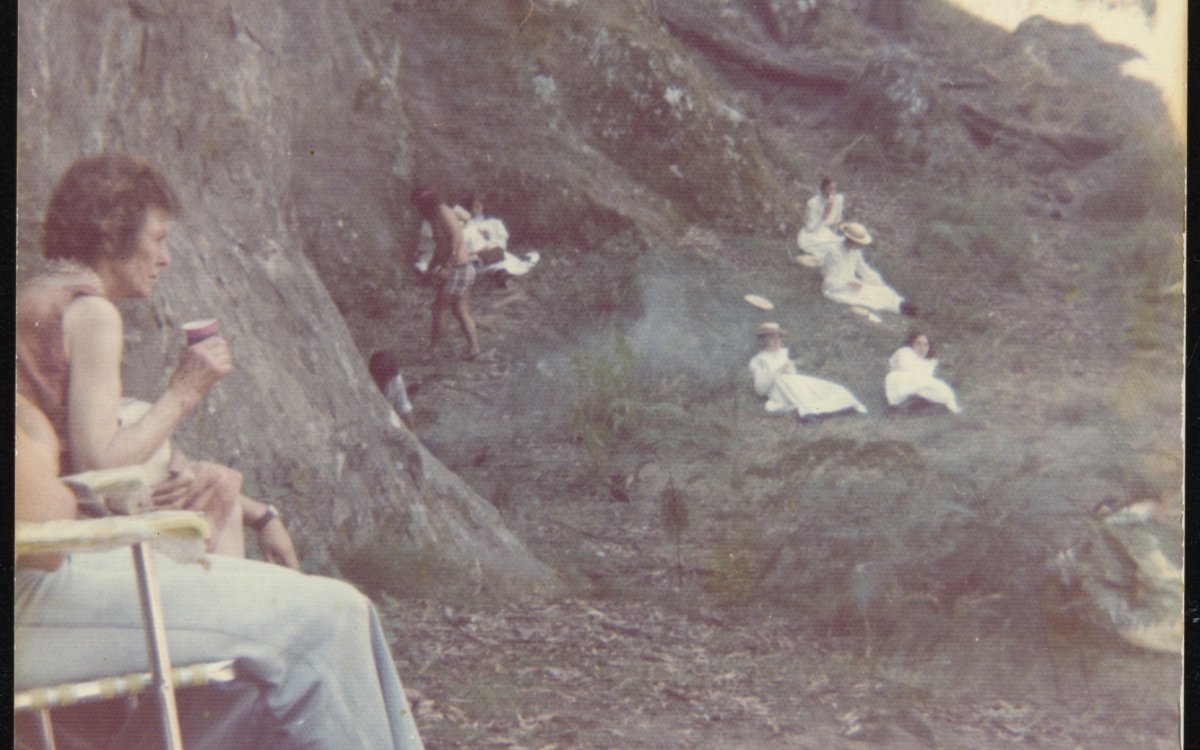
Peake, Cathy & Lindsay, Joan, 1896-1984. (1889). Papers of Cathy Peake relating to Joan and Daryl Lindsay, 1889-1988 [manuscript]. https://nla.gov.au/nla.cat-vn828193

Peake, Cathy & Lindsay, Joan, 1896-1984. (1889). Papers of Cathy Peake relating to Joan and Daryl Lindsay, 1889-1988 [manuscript]. https://nla.gov.au/nla.cat-vn828193

Peake, Cathy & Lindsay, Joan, 1896-1984. (1889). Papers of Cathy Peake relating to Joan and Daryl Lindsay, 1889-1988 [manuscript]. https://nla.gov.au/nla.cat-vn828193

Peake, Cathy & Lindsay, Joan, 1896-1984. (1889). Papers of Cathy Peake relating to Joan and Daryl Lindsay, 1889-1988 [manuscript]. https://nla.gov.au/nla.cat-vn828193
Lindsay originally wrote an 18th chapter that explains what happened to the missing girls at Hanging Rock, but decided not to publish it following advice from her publisher. Perhaps because the book doesn’t explain what happened to the missing parties, the book became a huge success. Prominent Australian director Peter Weir directed a film adaptation of the text. Weir’s adaptation also left the mystery unanswered.
Lindsay refused to ever tell the public what happened to the girls and their teacher, but readers have come up with numerous theories about what happened. Hanging Rock was rumoured to be a haunt of the notorious bushranger Mad Dog Morgan and some suspected he had killed the girls. Others had a theory that they were caught under a rock fall. Still others thought up far more mystical explanations.
1. After reading the book, watch the film with your class. Discuss some of the themes and motifs throughout the book and in the film (time, insects, birds, the bush) and use them to decide for yourself what happened.
2. With some of those themes in mind, ask each student to write the missing 18th chapter that explains what happened to the missing girls and teacher.
Alternatively, ask students to get into small groups. Each group should decide on an ending, create a storyboard of what happened, then use a smart phone/camera/tablet to film the final chapter and share it with the class.
As a class, discuss the endings that the students decided on.
3. Once students have presented their endings to the story, explain that, after Lindsay’s death, The Secret of Hanging Rock was published, containing the originally unpublished 18th chapter that explains what happened to the missing girls and teacher.
- Ask the students whether they want to know what the missing chapter says.
- Was Lindsay’s publisher right to cut the chapter?
- Does knowing the original ending change how you feel about the novel? Do you like it more, or less? Is it still a mystery?







